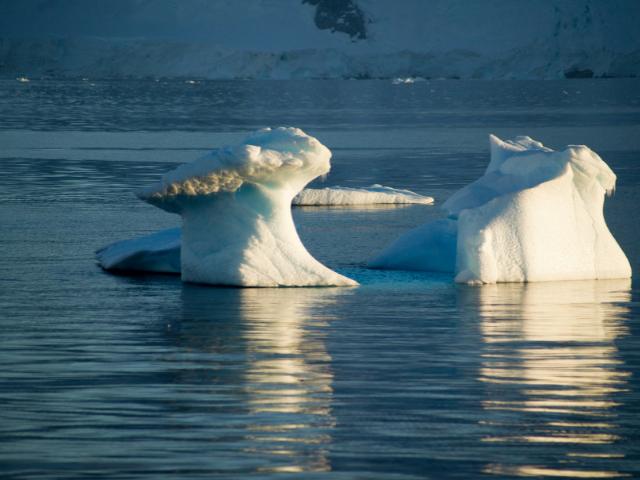
Two Antartica icebergs floating on calm water with intricate, wave-like formations, set against a dark icy landscape in a serene polar environment. Photo by Torsten Dederichs on Unsplash.
How Melting Ice Shapes Our Climate, Water, and Future—and What We Can Do to Protect It
Did you know that Greenland is losing 30 million tons of ice every hour? This isn’t just a shocking statistic—it’s a wake-up call. The melting of the world’s ice isn’t just a problem for cold regions; it’s an issue that impacts all of us, from the water we drink to the air we breathe. This week we examine the importance of Earth’s ice, the alarming changes it’s undergoing, and why it matters to your life.
The Big Picture: What Is the Cryosphere?
The “Cryosphere” might sound like a complicated word, but it simply means all the parts of Earth covered in snow and ice. This includes glaciers, ice sheets, permafrost (frozen ground), and sea ice.
Why does the cryosphere matter?
- Temperature Regulation: The cryosphere reflects sunlight, keeping the planet cool, much like a natural air conditioner.
- Water Storage: It stores about 70% of the world’s fresh water, feeding rivers and supporting billions of people.
Without the Cryosphere, Earth would be hotter, drier, and much less hospitable.
Alarming Changes in Ice and Snow
The Cryosphere is changing fast, and the consequences are already being felt worldwide. Greenland is losing ice at an unprecedented rate, enough to raise sea levels significantly in the coming decades. Glaciers in the Alps and Himalayas are melting at record levels, threatening water supplies for millions of people downstream.
In addition, Antarctic sea ice is shrinking, with three consecutive years of record lows. This destabilizes the Antarctic ice sheet, which could lead to catastrophic sea-level rise. And, frozen ground in Arctic regions is thawing, releasing harmful greenhouse gases like carbon dioxide and methane. This accelerates global warming and damages infrastructure in those regions.
Why It Matters to You
Melting ice may seem like a distant problem, but its effects are closer to home than you think.
- Rising Seas: As ice melts, sea levels rise, threatening coastal cities and communities. Major cities like New York, Miami, and Mumbai face increased flooding risks.
- Water Supply: Snow and ice act as reservoirs, releasing water during warmer months. With less snowpack, regions like the Himalayas and Andes face water shortages, impacting agriculture and drinking supplies for billions.
- Changing Weather: Melting ice disrupts weather patterns, leading to stronger storms, unpredictable rainfall, and even impacts on fisheries as oceans warm and acidify.
The Path Ahead: What Scientists Say
The Cost of Inaction
If emissions continue at current levels, global temperatures could rise by 3°C or more by the end of this century. This would push many regions beyond their ability to adapt, leading to economic and human costs that are unimaginable.
Hope Through Action
The good news? Scientists agree that if we act now to limit warming to 1.5°C, we can slow ice loss and reduce long-term damage. This requires cutting emissions by 50% by 2030 and reaching net-zero by 2050.
What Can Be Done?
Global Solutions
To address the challenges posed by melting ice and its global impacts, reducing emissions is a critical step. Transitioning to renewable energy sources like wind and solar can significantly cut greenhouse gas emissions, slowing the pace of global warming and ice loss. Additionally, protecting vulnerable areas is essential. Investing in resilient infrastructure and implementing policies designed to safeguard communities can help mitigate the risks of rising seas and water shortages, ensuring these regions are better prepared for the future.
Individual Steps
You don’t have to be a scientist or policymaker to make a difference. Here’s how you can help:
- Advocate for climate-friendly policies in your community.
- Use public transport, conserve energy, and support sustainable products.
- Spread awareness by sharing what you’ve learned with friends and family.
Summing Up
Saving the world’s ice isn’t just about preserving glaciers—it’s about protecting our homes, food, and future. The actions we take today will shape the world for ourselves as well as future generations. Each degree of warming we prevent reduces the risks to our planet and ourselves. Let’s work together to ensure that ice continues to cool the Earth, sustain life, and inspire hope for a better tomorrow.
International Cryosphere Climate Initiative. (2024). State of the cryosphere 2024: Lost ice, global damage. International Cryosphere Climate Initiative. Retrieved from https://iccinet.org/statecryo24/.
